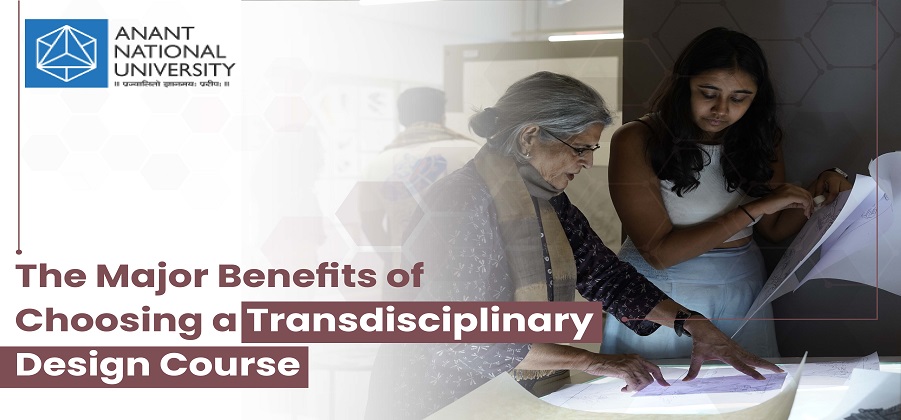

Today’s global business platforms holding all ranges of industries require professionals with multiple skills. Simultaneously, students of today’s generation also aspire to opt for courses that offer them stability and ability to handle multiple disciplines. This dual requirement has led to the introduction of one of the unique interdisciplinary courses that buckle up with design-oriented education, i.e., transdisciplinary design courses.
This course stands tall with a huge welcome among students owing to its value, yet is being provided in only a few top colleges, including Anant National University, India’s first DesignX university.
Let us explore the benefits of taking up a transdisciplinary design course.
| Table of Contents 1. What is Transdisciplinary Design? 2. Transdisciplinary Design course at Anant National University 3. Advantages of pursuing transdisciplinary design course 5. Conclusion 6. FAQs |
The world today is plagued with complex issues that make the process of designing solutions complicated. As the complexity of the problem or condition expands, deriving solutions to the problem turns adversely complex. So, complex solutions require complex minds that can shift and drift through multiple disciplines, and incorporate strategies from all to arrive at stupendously welcoming solutions.
Training and educating people is all that transdisciplinary design deals with. In simple terms, transdisciplinary design meaning is to venture into multiple disciplines to design a solution.
Also Read: The Future Trends in Communication Design Industry in India
Understanding and analyzing the needs of present and future global society, Anant National University always amazes, providing unique educational courses. One such course is Bachelor of Design in Transdisciplinary Design.
Bachelor of Design in Transdisciplinary Design is a quirky design course that incorporates design aspects from various disciplines such as graphic design, product design, space design and much more.
Here are the transdisciplinary design course details:
| Course Name | Bachelor of Design (B.Des.) in Transdisciplinary Design |
| Course Description | This course is a culmination of design knowledge from various disciplines that enhances the ideating and designing power of the students.
Students are educated with various design concepts, techniques, procedures and much more, thus preparing them as ideal designers capable of designing solutions for conditions of any complexity. |
| Level | Undergraduate Level |
| Duration | 4 years |
| Eligibility Criteria | The basic eligibility criteria to seek admission to transdisciplinary design courses at Anant National University are as follows:
● Candidates should have completed 10+2 or equivalent under any stream from any recognized educational institution. ● Candidates should have scored at least 50% aggregate in 10+2. |
| Admission Procedure | Admission to the Transdisciplinary Design course at AnantU requires students to take up the DET exam conducted by them.
On clearing DET, candidates will be invited for a sketch round, personal interaction and portfolio round to analyze their skills. Based on all these assessments admission will be provided. |
| Course Curriculum | Transdisciplinary curriculum design is curated with subjects that introduce students to tools and techniques for designing solutions to complex problems of multidisciplinary nature. |
As the world today requires expert minds who can design expert solutions that can break down the complexity of various situations, taking up a transdisciplinary design course will be a major set-up in one’s career.
Let us explore the major benefits that await pursuing a transdisciplinary design course:
One of the remarkable benefits of pursuing a transdisciplinary design course is that it offers the ability to resolve global problems.
As one pursues a transdisciplinary design course, s/he inculcates the ability to understand and analyze a problem from various perspectives and can develop solutions that are multidisciplinary in nature.
One of the best transdisciplinary design examples that will accept this benefit is that in the engineering construction of a bridge civil engineers think in different ways from architecture while architecture thinks differently from the financial provider, a transdisciplinary designer thinks and ideates a design that matches the quality of civil engineering, aesthetics of architecture and budget of the finance.
Designers from different fields will have different approaches towards a condition or a situation, while transdisciplinary designers will have a combination of various design disciplines. This culmination will lead to the development of a unique design approach that defines a strong solution for complex problems.
The knowledge of different disciplines of design will help engineer solutions that meet the quality of all design facets, yet will stand undisputedly unique.
Pursuing a transdisciplinary design course offers the privilege to establish your career in multiple design disciplines and also provides the freedom to juggle between these design disciplines at any point in your career.
For example, a transdisciplinary designer can perform a job as a graphic designer as well as a product designer simultaneously due to their knowledge of multiple design facets.
The curriculum of transdisciplinary design is curated with a blend of subjects such as anthropometrics, design theory, construction materials, ethnography, UX, creative coding, product ergonomics, etc. Therefore, the transdisciplinary design course prepares students for wider career opportunities.
As per students’ opinions obtained on transdisciplinary design job scope, the replies are highly positive with a wide range of job varieties in various fields such as:
Also Read: Strengthening research culture at AnantU
As students pursue transdisciplinary design courses, the students also develop managerial skills as they play a major role in the design industry.
Some of the managerial skills gained along the course are:
As a whole, there are enormous benefits to opting for a transdisciplinary design course as it has the power to provoke and ideate solutions for complex problems.
Developing and designing solutions to various problems require massive complex skills and it is incorporated well in the transdisciplinary design course. As the world today is growing forward, so do the problems and requirements become difficult, so it is high time to find ways to solve complex situations with a multidisciplinary approach and it will become possible with a transdisciplinary design strategy.